How the ‘comet of the century’ became an astronomical disappointment – Space.com
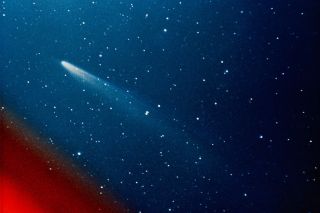
During the recent holiday season, while doing a bit of housecleaning, I came across a relic from 46 years ago:. a Christmas card from 1973 celebrating the impending arrival of what was supposed to be a once-in-a-lifetime sight — a dazzling comet, the Comet Kohoutek (C/1973 E1).
I looked at the card and let out a small sigh.
For those of a certain age, the name “Kohoutek” will always be linked to the celestial spectacle that never was. Christened for months as “The Comet of the Century,” the object never came remotely close to living up to expectations. As one of my fellow stargazing compatriots later commented: “It was one of the few comets that came with a fuse attached to it; it was a bomb of unbelievable proportions.”
Related: ‘Comets of the Centuries’: 500 years of the greatest comets ever seen
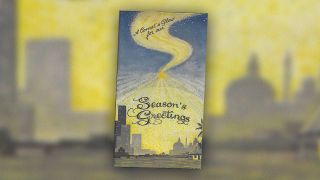
Big expectations
Comet Kohoutek was discovered at Hamburg Observatory in Germany by astronomer Dr. Lubos Kohoutek (pronounced “Ko-ho-tek”) on March 7, 1973, while he was making photographic observations of asteroids. When first sighted, the comet was some 465 million miles (748 million kilometers) from the sun, out near the orbit of Jupiter (although nowhere near the planet itself). At the time, this was a record farthest distance for the discovery of a comet, and it was then relatively bright, as far as comets go, for being so far from the sun. The hope was that if it was so bright and unusual then, it would continue to be bright and unusual as it neared the sun.
But it merely remained unusual rather than getting bright.
The first predictions indicated that Kohoutek would become visible to the naked eye in early November, in the early morning sky, and brighten to second magnitude (as bright as Polaris, the North Star) by Thanksgiving, and then become as bright as the planet Jupiter (magnitude -2) by mid-December. On Dec. 28, the comet would arrive at perihelion — its closest point to the sun — just 13.2 million miles (21.2 million km) away. Estimates of its brightness then ranged upwards to a resplendent magnitude of -10 — so bright that it might be possible to see the comet in full daylight with the naked eye, by simply blocking the sun with an outstretched hand.
Then all through January 1974, the comet, having switched over into the evening sky, was forecast to evolve into a spectacular object, accompanied by a long gossamer tail so bright that even from big cities it would be plainly evident. Racing back out into the distant reaches of space, the comet would slowly fade, finally becoming invisible to the naked eye by mid-February.
Comet craze
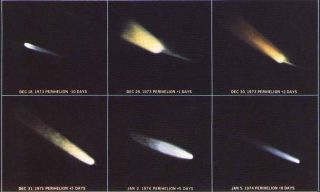
The prospect of such a bright comet sent the mainstream media into a frenzy. By mid-summer of 1973 everybody was aware of the amazing sky show that was being promised by year’s end. Tours were arranged to dark-sky sites to view it. There was even a special three-day “Comet Kohoutek Cruise” in December 1973 on the iconic passenger cruise ship Queen Elizabeth II, which would sail out into the Atlantic to look for the comet. There were all sorts of comet paraphernalia put into circulation: T-shirts, hats, books, badges, and yes, holiday-greeting cards galore.
The only problem? The comet brightened … but at a much slower rate than expected.
By the end of November, the comet was barely visible to the naked-eye and during December it shone 50 to 100 times fainter than anticipated. Countless numbers of people who arose before sunrise, looking for a stunning spectacle, saw nothing. Even the cruise ship ran into bad luck: Clouds constantly prevailed above with rough seas. On board was Dr. Kohoutek himself, who was to give a talk on “his” comet, but was unable to because he got seasick.
But then, as Kohoutek rounded the sun on Dec. 28, it suddenly became very bright, giving hope that it would more than make up for its poor showing in the morning sky by putting on a much better display as an evening object.
Best views were from space
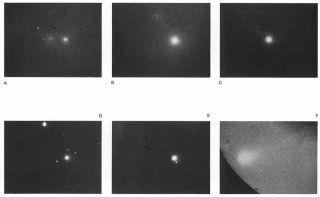
By far and away, the very best views of Comet Kohoutek were seen by three individuals who were orbiting 272 miles (438 km) above the Earth: NASA astronauts Gerald Carr, William Pogue and Edward Gibson: the crew of Skylab 3.
Gibson noted in the October 1974 issue of Sky & Telescope that “For us it was a very elegant and impressive sight. On December 29, 1973, one day after perihelion, the comet was first seen at sunset while Commander Carr and I were outside during extravehicular activity (EVA) and looking through sun visors. It was an awe-inspiring sight. The comet was extremely bright and had an unusual sunward spike. The overall color of the comet was bright yellow.”
But apparently, Kohoutek went on a splurge as it swept around the sun, shedding more gas and dust than anticipated. Unfortunately, the splurge was short-lived; only a week later, the comet dimmed rapidly, until it appeared no brighter than an ordinary star. “It was fainter than faint,” noted Gibson.
Related: Spectacular comet views from Earth and space
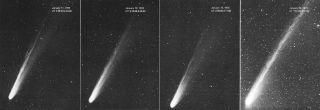
We deserved better.
Of course, most people on Earth were expecting to see something akin to a spotlight in the night sky during the first two weeks of January 1974. American humorist Art Buchwald wrote a satirical column that was syndicated in many newspapers. The columnist contacted the fictional Universal Star Company, complaining about the comet which Buchwald claimed was a fraud. “I was promised a dazzling display of celestial brilliance that would fill the sky with a million moons,” Buchwald wrote, to which the faux company’s response was, “Your comet was recalled. It had a faulty tail and a bad paint job.”
By mid-January, binoculars or a telescope were needed to find the comet.
Gibson also wrote: “To have viewed Comet Kohoutek as we did from Skylab was a rare opportunity, and our only regret is that everyone on the ground could not see it equally well while it was so close to perihelion.”
In the end, Kohoutek was labeled as the “Flop of the Century” or simply “Comet Ko-flop-tek.” Astronomy ended up with a public-relations black eye, and because they were “burned,” the mainstream media made certain to steer clear of any future stories regarding the subject of comets. This was truly unfortunate, because just two years later, another comet — Comet West (C/1975 V1) — put on a spectacular show in the predawn skies of early March 1976, briefly becoming bright enough to be glimpsed in daylight and developing not one, but several tails. But it received only short shrift in newspapers, while radio and television all but ignored it.
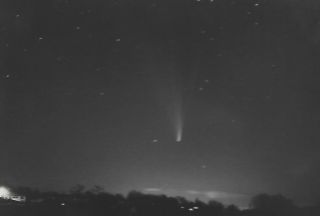
What happened?
The root of all the excitement centered on Kohoutek’s abnormal brightness at the time of discovery, which suggested that it was an unusually large and active object. What we have since learned is that Kohoutek was a “new” comet in a parabolic orbit — that is, it never passed near the sun before — and its surface was likely covered with very volatile materials such as frozen nitrogen, carbon monoxide and carbon dioxide. These ices vaporize far from the sun, giving a distant comet a short-lived surge in brightness that can raise unrealistic expectations.
Several other flops have appeared over the years. In addition to Kohoutek, there was Comet ISON (C/2012 S1), which disintegrated when it swept very near to the sun during Thanksgiving 2013, and Comet Austin (C/1989 X1), which was promoted as potentially a “monster comet” in the spring skies of 1990, but never got much brighter than fifth magnitude – barely bright enough to be seen with the naked eye.
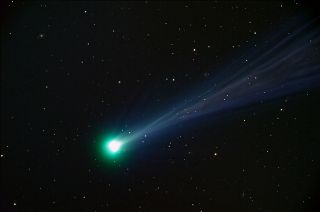
Then there was Comet Cunningham (C/1940 R2), which was expected to become a rather spectacular sight during the Christmas season of 1940. Like Kohoutek, the prospect of a bright Christmas comet came with lots of favorable publicity. Astronomers of that pre-World War II era were frequently queried as to when would be the best time to view it, as well as how to photograph it. At Harvard Observatory, astronomers received a telegram, since published in Sky & Telescope, that gave an indication of what most expected:
“Greatly interested [in] your report that Cunningham’s comet will flame across the sky this Christmas season. It reminds me of another great star which upon another Christmas, portended the coming of Christianity and peace and good will to men. I should like to photograph this comet for the Queen of Queens, screen drama of Mary of Nazareth. Will appreciate your opinion regarding photographic possibilities. Please wire me at my expense Paramount Studios, Hollywood. Cecil B. De Mille.”
But Comet Cunningham was a “first-timer” like Kohoutek, and soon after it was discovered its initial surge of brightness inexplicably slowed. By Christmas the comet was only one-hundredth as bright as predictions had originally indicated — another flop!
Still rife with uncertainty
We can’t arbitrarily state with absolute certainty that all new comets turn into duds. Comet Arend-Roland (C/1956 R1) was a first-timer that put on a dramatic show during the spring of 1957. So there is always a “chance” that even a new comet can evolve into a spectacular celestial showpiece. We can never really be sure.
Lastly, the predictions on Kohoutek were based on what could be expected from it compared to an “average comet.”
The trouble is, there apparently is no such thing as an “average comet.”
If there is a proverb to this essay, I leave you with this oft-quoted statement from comet expert Dr. Fred L. Whipple: “If you must bet, bet on a horse, not a comet.”
Joe Rao serves as an instructor and guest lecturer at New York’s Hayden Planetarium. He writes about astronomy for Natural History magazine, the Farmers’ Almanac and other publications. Follow us on Twitter @Spacedotcom and on Facebook.






